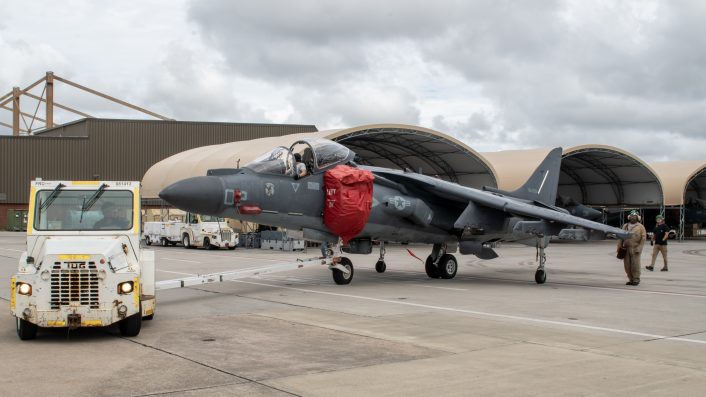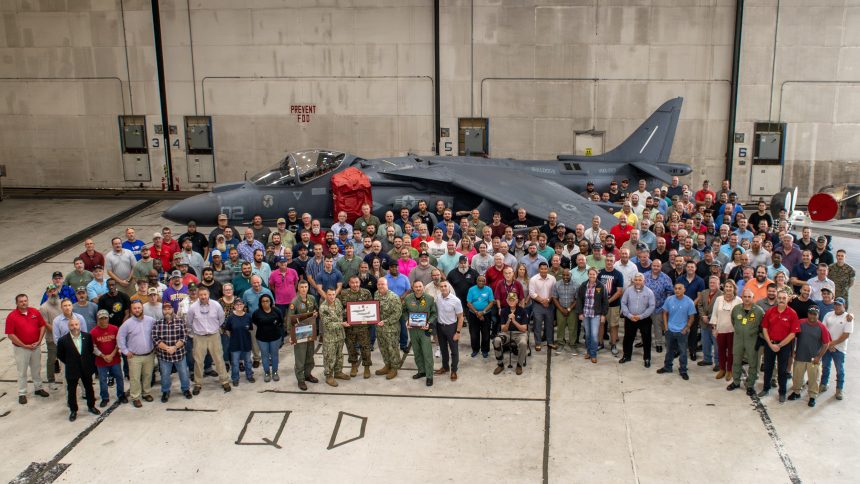Fleet Readiness Center East (FRCE) recently marked a significant chapter’s end by completing its last AV-8B Harrier maintenance overhaul.
As the U.S. Marine Corps proceeds with its plan to retire all AV-8B+ Harrier II jets by 2026, Fleet Readiness Center East (FRCE), a Naval Aviation maintenance and repair depot under the Naval Air Systems Command, delivered the final Harrier to Marine Attack Squadron 223 at Marine Corps Air Station Cherry Point on Sept. 26, 2024.
Based at Marine Corps Air Station Cherry Point in North Carolina, FRCE’s mission is to support the operational readiness of various military aircraft, providing comprehensive maintenance, repair, and overhaul services for U.S. Navy and Marine Corps aviation assets.
To honor the long relationship with the Harrier, FRCE held a commemorative gathering in its AV-8 hangar on Sept. 20, where Capt. Randy Berti, FRCE Commanding Officer, alongside leaders from the AV-8B Weapon Systems Program Office, recognized the extraordinary dedication and technical skill of the depot’s Harrier team. Capt. Berti expressed his pride in the facility’s five-decade legacy supporting the Marine Corps and allied Harrier squadrons, attributing the program’s success to the unwavering dedication of multiple generations of FRCE personnel.

FRCE has supported Harrier maintenance since 1973, beginning with the AV-8A model and its F402 engine, and has played an integral role in extending the platform’s operational life. With the Marine Corps now shifting to the advanced F-35 Lightning II, FRCE’s Harrier team is adapting its expertise to this new platform. Many technicians who have devoted much of their careers to the Harrier are now facing this transition, including Mike Stewart, Aircraft Overhaul and Repair Supervisor, who has worked on AV-8s for 30 years. Stewart expressed a mix of nostalgia and optimism, noting that while the AV-8 has been his primary focus since his own days in the Marine Corps, he recognizes the importance of evolving with the latest technology to ensure fleet readiness.
“The F-35 represents the next phase in capability, allowing us to continue supporting the Marine Corps mission well into the future,” Mike Stewart, Aircraft Overhaul and Repair Supervisor.
Jeff Broughton, business operations specialist, added that the Harrier team has set a standard of efficiency, often completing depot-level repairs faster than initial estimates. This track record of meeting and exceeding budgetary goals has strengthened FRCE’s standing as a trusted repair hub for the AV-8 community. Reflecting on notable moments in his career, Broughton recalled the team’s rapid turnaround on an AV-8 damaged during the attack on Camp Bastion, Afghanistan.
On Sept. 14, 2012, Taliban insurgents breached the perimeter of Camp Bastion and targeted the flight line where the U.S. Marine Corps’ AV-8B Harriers were stationed. The assault was highly organized: 15 heavily-armed insurgents wearing U.S. Army uniforms infiltrated the base and launched a surprise attack using small arms, grenades, and rocket-propelled grenades (RPGs). The attack lasted several hours, resulting in significant losses for the Harrier squadron stationed there, Marine Attack Squadron 211 (VMA-211), also known as the “Wake Island Avengers.” The attackers destroyed six AV-8B Harriers and damaged two more, effectively halting the squadron’s operational capability in Afghanistan.
In addition to the destruction of aircraft, the attack claimed the lives of two Marines, Lt. Col. Chris “Otis” Raible, the commanding officer of VMA-211, and Sgt. Bradley Atwell.
The attack underscored the vulnerability of even well-defended forward operating bases, spurring changes in base security protocols and heightening awareness around the protection of valuable aviation assets. The Harrier community, deeply impacted by this event, rallied to restore the squadron’s capability, and the incident remains a significant chapter in Marine Corps aviation history. The Marine Corps moved quickly to rebuild the squadron, receiving additional Harriers and support to bring VMA-211 back to combat readiness.
“Knowing the circumstances motivated us to get the aircraft back to the squadron quickly, and we succeeded in finishing a week ahead of schedule and under budget,” Broughton said. He credits this accomplishment to the team’s commitment to supporting combat readiness, adding that such achievements have made FRCE the repair center of choice for future squadrons as they transition to new aircraft.
As the AV-8 program officially concludes, Ike Rettenmair, head of FRCE’s AV-8 and F-35 branches, reflected on the legacy of the Harrier, which he has supported for 30 years, from his time as a Marine Corps airframe mechanic to his leadership role today. Rettenmair described his mixed emotions as the last Harrier rolled out of the hangar but emphasized the pride and excitement he feels as FRCE embraces its role in the F-35 program, supporting the warfighter with cutting-edge capability.
“We’ve been fortunate to work with some of the most dedicated individuals in the fleet. As we transition, the same commitment to excellence will drive our support for the next generation” Ike Rettenmair, head of FRCE’s AV-8 and F-35 branches.
With over 4,000 civilian, military, and contract employees, FRCE remains North Carolina’s largest provider of maintenance, repair, overhaul, and technical services, with annual revenue exceeding $1 billion. Supporting the broader U.S. Navy and allied nations, FRCE will continue to evolve its role as it shifts focus from legacy aircraft to the high-tech platforms of the future, carrying forward a legacy of service and readiness that has defined the depot for decades.









